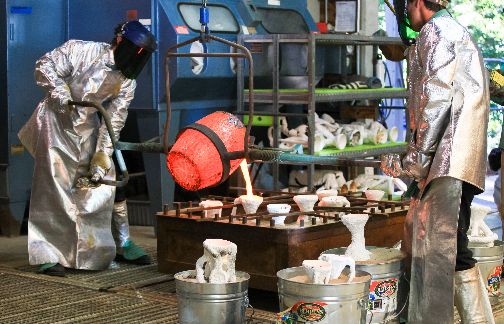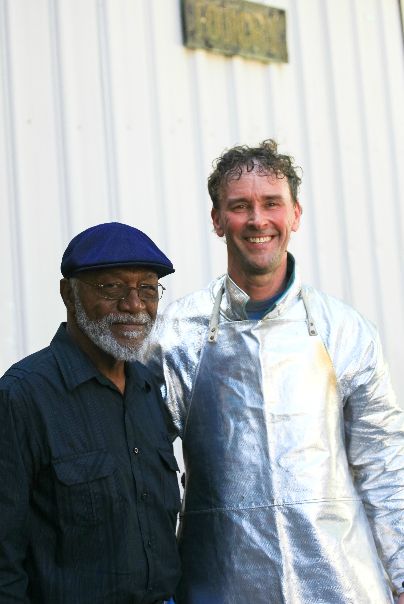Cowell College art major Katherine Randall perched anxiously on a high stool Tuesday afternoon as the result of six weeks of painstaking work awaited the outcome of the next 30 minutes.
“There’s a lot of work, a lot of tears,” she said over the roar of a venting hood as Arts Lecturer Sean M. Monaghan began melting 250 pounds of silicon bronze, which would be turned—barring unintentional cracks, holes or explosions—into sculptures created by Randall and 17 other students in his Art 188 class.
“Hopefully,” said Randall, who graduates in June, “it will all be worth it once it’s fully realized.”
Randall wasn’t the only nervous one in the crowd as about two dozen students and onlookers watched what has become a tradition at UC Santa Cruz: a bronze pour at the UC system’s last working foundry.
It’s an event that’s part performance and part ancient ritual with a lot of hands-on hard work mixed in. Outfitted in aluminized Kevlar jackets, aprons and gloves, Monaghan and his helpers first heated the bronze to a blazing 2,100 degrees Fahrenheit, then used a crane to lift the white-hot crucible of molten metal and pour what resembled a stream of liquid sunshine into molds students had made.
The molds themselves required weeks of work as the student sculptors crafted their designs out of wax, dipped the wax forms into ceramic slurry and then fired them in a kiln so that the poured metal would fill the empty spaces where the wax had been to create a 3-D sculpture.
It’s a rite that has been going on almost continuously since the earliest years of UC Santa Cruz, when the first foundry began operating out of the Cowell Ranch’s old blacksmith’s barn.
“It was very crude,” said Art Professor Emeritus Doyle Foreman of the first facility —and also something of a fire hazard. But it was a can-do time when pioneer faculty like Foreman, who began teaching in 1968, foraged for downed redwood and convinced construction workers to dump a tractor load of clay soil for students to use in their art projects. With the help of a $150,000 capital improvement grant, Foreman helped design a new, and safer, foundry, which was erected in 1975 behind the Theater Arts complex.
Tuesday, Foreman, 82, sat in the large metal building and watched a process he’d overseen for years.
“The wax is malleable. It’s very easy to manipulate,” said Foreman of the first phase of the sculpting process. “It’s like painting. It responds to you so there is a very personal kind of connection.” The material and the artist both evolve until an idea becomes physical, he said.
That kind of release of ideas through form gives students confidence, according to Foreman.
For Samuel Mora (Kresge ’17, art), who had created a sculpture that he said reflected the duality of his personality—quiet at times and outgoing at other times—the process taught him not only patience but also about facing problems.
“It teaches you that if something happens you can learn to work with it or work around it,” he said. “It’s something you can apply to life. It teaches you to be a better human.”
The pour, which required the choreographed work of five people including Monaghan’s studio research assistant Lucas Gasperik, ended with a burst of applause when a smiling and sweating Monaghan removed his welder’s helmet to announce with a smile: “And that’s all there is to it.”
Monaghan (Kresge ’83, art), who operates his own foundry business called Bronze Works Fine Arts Foundry in Santa Cruz, said, just like his students, he still gets a thrill from a pour event.
“It’s like a birthday because you get to open the present you’ve been working on for six weeks,” said Monaghan, “and then, there it is: all your hopes and dreams.”





